
|
You entered: comet tail
 Hyakutake: Stars Through A Comet Tail
Hyakutake: Stars Through A Comet Tail
17.07.1998
Comets are cosmic icebergs. They follow very elongated orbits which carry them from the frozen, remote outer reaches of the Solar System to close encounters with the Sun. Heated by sunlight, they slough off layers of material as gas and dust, forming their characteristic awe-inspiring comas (heads) and tails.
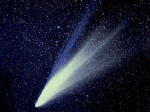 Two Tails of Comet West
Two Tails of Comet West
26.08.1995
Here Comet West is seen showing two enormous tails that wrap around the sky. The ion tale of a comet usually appears more blue and always points away from the Sun. The dust tail trailing the comet's nucleus is the most prominent.
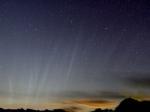 A Comet Tail Horizon
A Comet Tail Horizon
23.01.2007
What's happening over the horizon? Many a sky enthusiast who thought they had seen it all had never seen anything like this. To the surprise of many Northern Hemisphere observers, the tail of Comet McNaught remained visible even after the comet's head set ahead of the Sun.
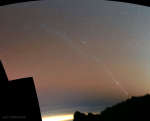 Comet Leonards Long Tail
Comet Leonards Long Tail
2.01.2022
You couldn't see Comet LeonardБs extremely long tail with a telescope Б it was just too long. You also couldn't see it with binoculars Б still too long. Or with your eyes -- it was too dim. Or from a city Б the sky was too bright.
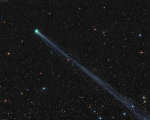 Long Tailed Comet SWAN
Long Tailed Comet SWAN
7.05.2020
Blowing in the solar wind the spectacular ion tail of Comet SWAN (C/2020 F8) extends far across this 10 degree wide telephoto field of view. Captured on May 2 its greenish coma was about 6 light-minutes from Earth. The pretty background starfield lies near the border of the constellations Cetus and Aquarius.
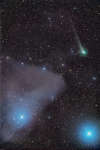 Stardust and Comet Tails
Stardust and Comet Tails
19.08.2022
Heading for its closest approach to the Sun, or perihelion, on December 19 comet C/2017 K2 (PanSTARRS) remains a sight for telescopic observers as it sweeps through planet Earth's skies in the constellation Scorpius.
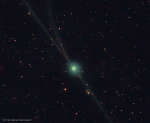 Almost Three Tails for Comet Encke
Almost Three Tails for Comet Encke
19.02.2017
How can a comet have three tails? Normally, a comet has two tails: an ion tail of charged particles emitted by the comet and pushed out by the wind from...
 Another Tail for Comet Garradd
Another Tail for Comet Garradd
3.03.2012
Remarkable comet Garradd (C2009/P1) has come to be known for two distinctive tails. From the perspective of earthbound comet watchers the tails are visible on opposite sides of its greenish coma. Seen here in a telescopic view, the recognizable dust tail fans out to the right, trailing the comet nucleus in its orbit.
 APOD: 2024 October 7 Б The Long Tails of Comet Tsuchinshan ATLAS
APOD: 2024 October 7 Б The Long Tails of Comet Tsuchinshan ATLAS
6.10.2024
A bright comet is moving into the evening skies. C/2023 A3 (TsuchinshanБATLAS) has brightened and even though it is now easily visible to the unaided eye, it is so near to the Sun that it is still difficult to see. Pictured, Comet TsuchinshanБATLAS was captured just before sunrise from an Andes Mountain in Peru.
 The Magnificent Tail of Comet McNaught
The Magnificent Tail of Comet McNaught
5.12.2009
Comet McNaught, the Great Comet of 2007, was the brightest comet of the last 40 years. Its spectacular tail spread across the sky and was breathtaking to behold from dark locations for many Southern Hemisphere observers.
|
January February March |
||||||||||||||||||||||||||||||||||||||||||||||||||||||||